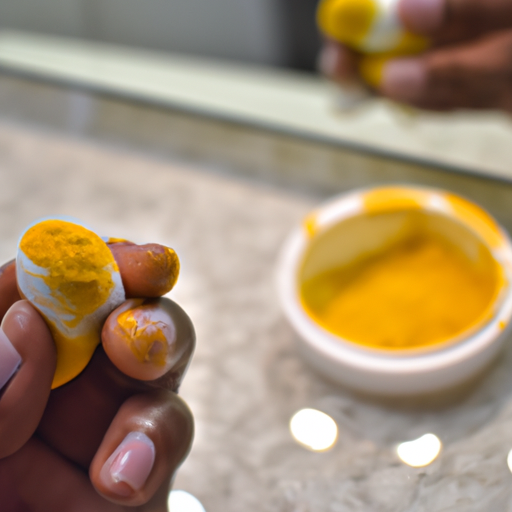As someone who cares about their health, I always ensure I have fresh and dried turmeric root in my kitchen. Turmeric has a long history in traditional medicine due to its powerful anti-inflammatory and antioxidant properties. Studies have shown that it can help reduce arthritis pain, boost brain function, and potentially prevent cancer.
However, as with any natural product, the lifespan of turmeric root is limited, and it is crucial to know how long it can last to maximize its health benefits.
In this article, I will discuss the various factors that affect the shelf life of turmeric root and how to store it properly to extend its lifespan. I will also provide tips on how to tell if turmeric root has gone bad and what to do with it when it has passed its prime.
With this information, you can ensure that you are getting the most out of your turmeric root and reaping its numerous health benefits.
Key Takeaways
- Proper storage conditions such as a cool, dry location in a sealed container or airtight bag can extend the lifespan of turmeric root up to one month for fresh and up to six months for dried.
- Spoiled turmeric root can cause food poisoning or bacterial infections, so it is important to know the shelf life and storage factors affecting it, such as temperature, humidity, and exposure to light.
- Freezing grated turmeric in an airtight container or pickling it can be effective preservation methods that increase its health benefits through fermentation.
- Using expired turmeric root in cooking is still possible by grinding it into a powder, but its potency may have decreased, requiring more to be used in recipes. Expired turmeric root can also be used for natural dye or beauty treatments.
The Importance of Knowing the Shelf Life of Turmeric Root
Knowing the shelf life of turmeric root is crucial, so you don’t end up using expired ingredients in your cooking. When turmeric root expires, it loses its flavor and potency, which can affect the taste and health benefits of your dishes. Expired turmeric root can also be harmful to your health as it can cause food poisoning or bacterial infections.
Uses for expired turmeric root include using it as a natural dye for fabrics or as a beauty treatment for glowing skin. However, it’s best to avoid using expired turmeric root in your cooking to prevent any health hazards.
Instead, opt for fresh turmeric root, which has numerous health benefits, including reducing inflammation, boosting brain function, and reducing the risk of chronic diseases. Buying fresh turmeric root also ensures that you get the best flavors and aroma, which can enhance the taste of your dishes and make them more appealing.
Factors affecting the lifespan of turmeric root include storage conditions, such as temperature, humidity, and exposure to light. These factors can cause turmeric root to spoil quicker, reducing its shelf life.
Additionally, the quality of turmeric root at the time of purchase can also affect its lifespan. By taking the necessary precautions and buying fresh turmeric root, you can ensure that you get the best flavors and health benefits from this superfood.
Factors Affecting the Lifespan of Turmeric Root
To keep your turmeric root fresh and flavorful for as long as possible, you should pay attention to the factors affecting its preservation and store it under optimal conditions.
These factors include temperature, humidity, light exposure, and the quality of the root itself.
Turmeric root is sensitive to changes in temperature and humidity, so it’s important to keep it in a cool and dry location, such as a pantry or a refrigerator.
Additionally, it’s best to store it in a sealed container or airtight bag to prevent moisture from getting in and causing spoilage.
Another important factor when it comes to preserving the lifespan of turmeric root is the quality of the root itself.
Fresh, healthy roots that haven’t been damaged or bruised will last longer than those that are already showing signs of decay.
When checking for spoilage, look for mold or a foul odor, as these are clear indications that the root has gone bad.
By paying attention to these factors and taking proper care of your turmeric root, you can ensure that it stays fresh and flavorful for as long as possible.
Now, let’s move on to how to store fresh turmeric root to maximize its lifespan and health benefits.
How to Store Fresh Turmeric Root
Keep your fresh turmeric root in a cool, dark place like a pantry or refrigerator to preserve its flavor and nutrients. Turmeric root can last up to one month when stored properly. You can also freeze fresh turmeric root to extend its shelf life for up to six months.
Using fresh turmeric root has many health benefits. It contains a compound called curcumin, which has anti-inflammatory and antioxidant properties. Curcumin has been shown to improve brain function, reduce the risk of heart disease and cancer, and even help with depression.
Fresh turmeric root can be used in a variety of recipes, such as smoothies, soups, and curries. Its bright orange color and unique flavor can add a vibrant and healthy twist to any dish.
When it comes to dried turmeric root, proper storage is just as important. However, the process is slightly different.
How to Store Dried Turmeric Root
If you want to preserve the flavor and nutrients of your dried turmeric root, you should store it in an airtight container in a cool and dry place. Here are some tips to help you store your dried turmeric root properly:
-
Use an airtight container: Air, moisture, and light can cause the turmeric root to lose its flavor and nutrients. Store the dried turmeric root in an airtight container to prevent air and moisture from getting in and to keep it away from light.
-
Choose a cool and dry place: Heat and humidity can cause the turmeric root to lose its flavor and nutrients. Store the dried turmeric root in a cool and dry place, such as a pantry or cupboard, away from direct sunlight and sources of heat.
-
Refrigerate for longer storage: If you want to store your dried turmeric root for a longer period of time, consider storing it in the fridge. This will help to keep it fresh for longer and prevent it from spoiling.
-
Use the right amount in cooking: Dried turmeric root can be used in a variety of dishes, such as curries, soups, and stews. However, it’s important to use the right amount in cooking to avoid overpowering the dish. A general rule of thumb is to use about 1 teaspoon of dried turmeric root for every 4 servings of food.
Knowing how to properly store your dried turmeric root is important to ensure that it stays fresh and retains its flavor and nutrients. However, even with proper storage, turmeric root can eventually spoil. In the next section, we’ll discuss some signs of spoilage to look out for.
Signs of Spoilage
You don’t want to risk consuming spoiled turmeric root, so it’s important to be aware of the signs of spoilage. One of the most common signs of spoilage is the presence of mold or a mildew-like odor. If you notice any signs of mold, it’s best to discard the entire root as consuming mold can lead to serious health risks.
Another sign of spoilage is a change in color or texture. The root may become soft or mushy, and the color may change from bright orange to brown or black. If you notice any of these changes, it’s best to err on the side of caution and discard the root.
Consuming spoiled turmeric can lead to a range of health risks, including food poisoning, diarrhea, and nausea. It’s important to properly store your turmeric root and to only consume it when it’s fresh. If you do happen to come across a spoiled root, don’t attempt to use it in any way as it can still pose a risk to your health.
In the next section, we’ll explore how to tell if turmeric root is still good, so you can avoid the risks of consuming spoiled turmeric.
How to Tell if Turmeric Root is Still Good
Discovering whether your turmeric root is still fresh and full of flavor can be a fun and easy task. Here are three signs to look for when determining if your turmeric root has gone bad:
-
Smell: Fresh turmeric root has a pleasant, earthy aroma. If your turmeric root smells musty or moldy, it’s likely past its prime.
-
Appearance: Look for signs of mold or discoloration on the surface of the turmeric root. If it appears shriveled or slimy, it’s time to toss it.
-
Taste: If you’re unsure if your turmeric root is still good, give it a taste. Fresh turmeric root has a slightly bitter, peppery flavor. If your turmeric tastes off or bland, it’s time to replace it.
Despite its shelf life, there are a few ways to use turmeric root beyond its expiration date. One way is to grate it into dishes such as soups, stews, and curries. Another way is to make turmeric tea by steeping grated turmeric root in hot water.
However, it’s important to note that expired turmeric root may not have the same health benefits as fresh turmeric root. In the next section, we’ll discuss how to extend the lifespan of turmeric root to ensure maximum health benefits.
How to Extend the Lifespan of Turmeric Root
In the previous section, we explored how to determine if turmeric root is still good for consumption. But what if you want to extend the lifespan of turmeric root to ensure that it lasts as long as possible? There are a few ways to preserve turmeric and keep it fresh for longer.
Firstly, one of the most effective ways to extend the lifespan of turmeric root is to store it properly. Turmeric should be kept in a cool, dry place away from direct sunlight. It’s also important to keep the turmeric root in an airtight container to prevent moisture from getting in. Another way to preserve turmeric is to freeze it. Simply grate the turmeric root and freeze it in an airtight container. This will not only extend the lifespan of turmeric but also make it easier to use in cooking. Below is a table summarizing different turmeric preservation methods and their effectiveness:
| Preservation Method | Effectiveness |
|---|---|
| Storing in a cool, dry place | Good |
| Keeping in an airtight container | Good |
| Freezing grated turmeric | Very Good |
| Pickling turmeric | Good |
In addition to these preservation methods, pickling turmeric is another way to extend its lifespan. Pickled turmeric not only lasts longer but also has added health benefits due to the fermentation process. Studies have shown that the fermentation of turmeric can increase its antioxidant and anti-inflammatory properties. Overall, there are several ways to preserve turmeric and keep it fresh for longer. By using these methods, you can ensure that your turmeric root lasts as long as possible and retains its health benefits.
Moving on to the next section, we will explore how to use turmeric root past its shelf life.
Using Turmeric Root Past its Shelf Life
Utilizing turmeric root beyond its expiration date can be a challenge, but there are ways to still incorporate its flavor and health benefits into your cooking. One way to use expired turmeric root is by grinding it into a powder. This can be done using a spice grinder or a mortar and pestle.
The powder can then be used in recipes that call for turmeric, such as curries or soups. However, it’s important to note that the potency of the turmeric may have decreased, so you may need to use more than the recipe calls for.
In addition to its culinary uses, turmeric root has also been found to have numerous benefits for the skin. It contains curcumin, a compound that has anti-inflammatory and antioxidant properties. Studies have shown that topical application of curcumin can help improve skin texture and reduce the appearance of fine lines and wrinkles.
To use expired turmeric root in skincare, you can create a DIY face mask by mixing the powdered turmeric with other ingredients such as honey, yogurt, or coconut oil. This can be applied to the face and left on for 10-15 minutes before rinsing off.
Frequently Asked Questions
Can turmeric root be frozen to extend its lifespan?
Freezing turmeric root can extend its lifespan up to a year. To store turmeric root in the freezer, wash and dry it thoroughly, then wrap it in plastic or aluminum foil. Research shows that freezing turmeric root does not significantly affect its health benefits.
Can turmeric root be stored in the refrigerator?
Storing turmeric root in the refrigerator can extend its lifespan for up to a month. However, it may lose some of its potency and flavor. Alternative methods include freezing or drying. Studies suggest turmeric has anti-inflammatory and antioxidant properties.
Can turmeric root be used after it has started to sprout?
Wow, using sprouted turmeric root is a game changer! It’s packed with even more antioxidants than regular turmeric root, but be cautious as the texture may be tougher. Studies show potential benefits for inflammation and brain function.
Can turmeric root be stored in water or submerged in oil?
Storing turmeric root in water or oil is not recommended as it can lead to microbial growth and spoilage. Instead, store in a cool, dry place with good ventilation. Tips for bulk storage include using airtight containers and avoiding exposure to light.
Can turmeric root be stored in a pantry or should it always be refrigerated or frozen?
I always store my turmeric root in a pantry, but proper handling is key. Keep it in a cool, dry place and away from direct sunlight. It’s important to note that refrigeration or freezing can alter its flavor and potency.
Conclusion
In conclusion, knowing the shelf life of turmeric root is essential for maximizing its health benefits. Based on my research, the lifespan of turmeric root can be affected by various factors such as humidity, temperature, and storage location.
Storing fresh turmeric root in a cool and dry place, and dried turmeric root in an airtight container can help extend its lifespan. It’s important to note that while turmeric root may spoil over time, using it past its shelf life is still safe. However, the potency of its health benefits may diminish.
As a scientist, I’ve come across numerous studies that highlight the many benefits of turmeric root, such as its anti-inflammatory and antioxidant properties. Therefore, it’s crucial to properly store and use turmeric root to maintain its efficacy and optimize its health benefits.










